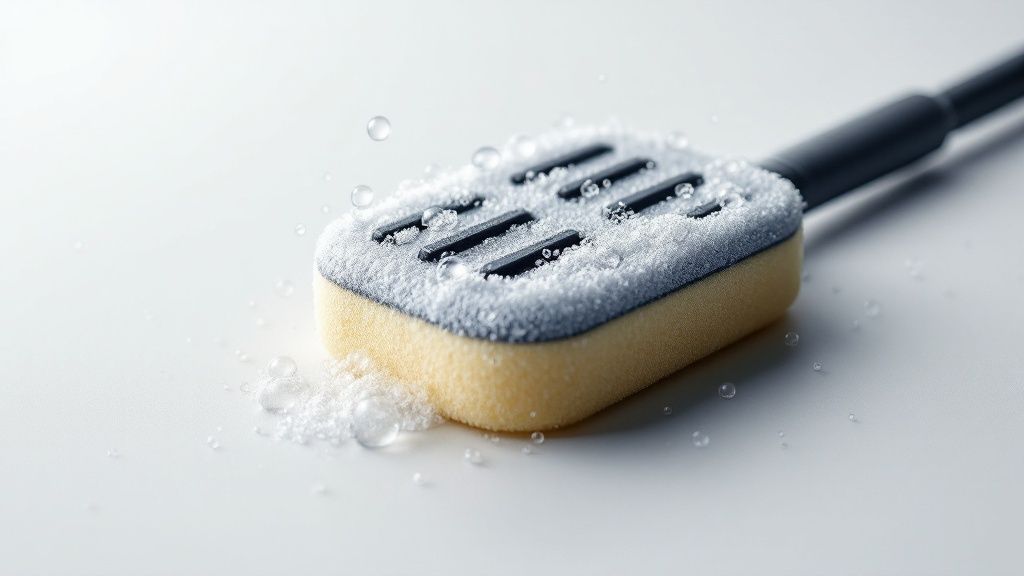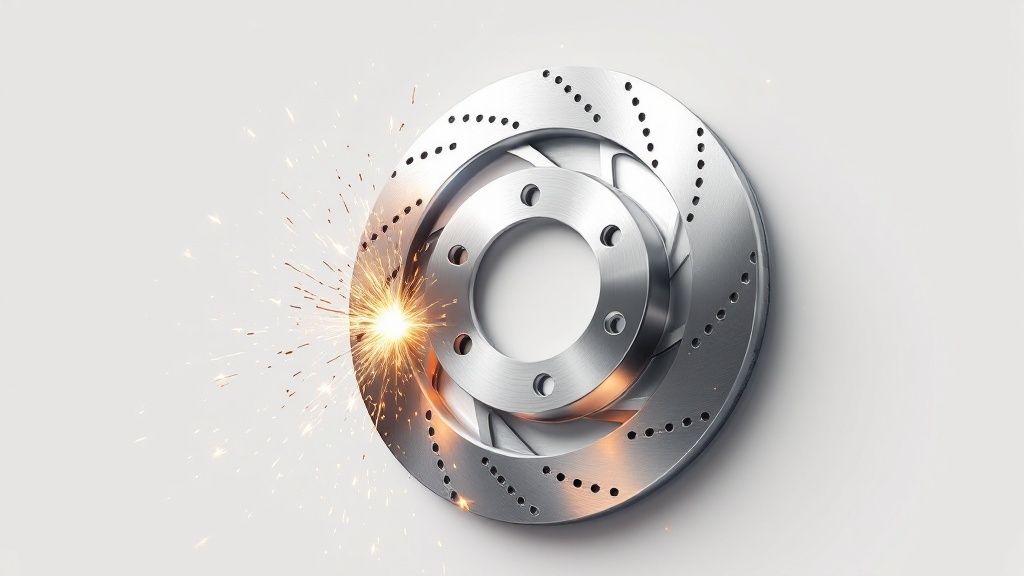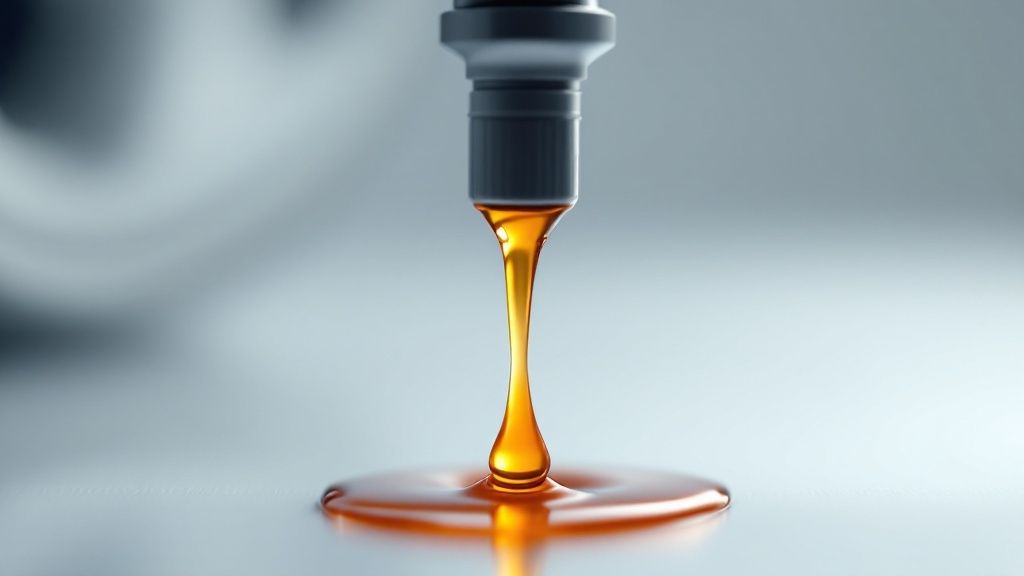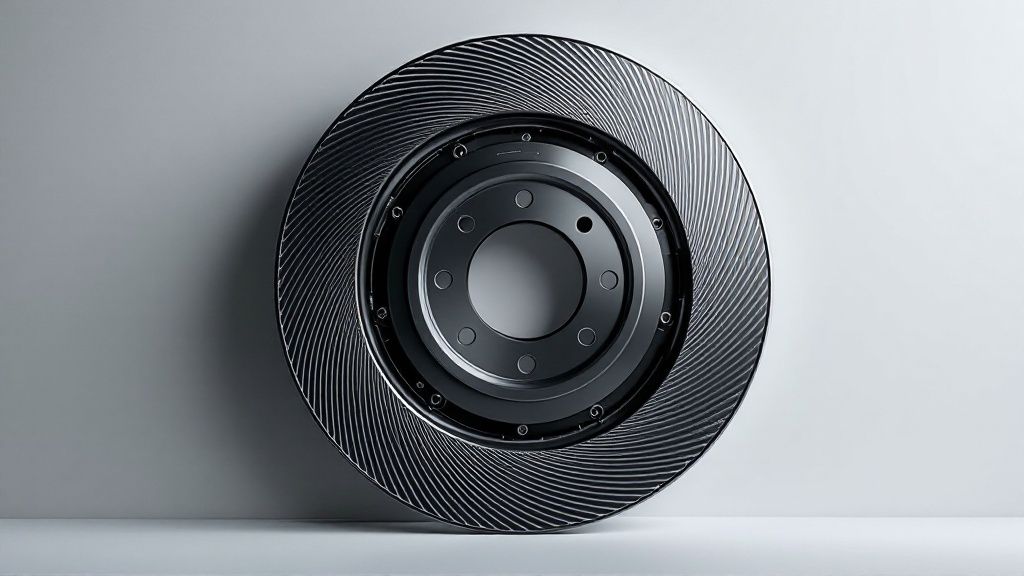This listicle helps you identify and understand seven common car brake problems. From a spongy brake pedal to grinding brakes, we'll cover the causes, symptoms, and potential solutions for each issue. Recognizing these car brake problems early is crucial for your safety and can prevent expensive repairs down the road. This information is essential for Dallas drivers, fleet managers, and anyone concerned about vehicle maintenance and safety. Learn what each symptom indicates and how to address it effectively.
A spongy brake pedal is a serious car brake problem that should never be ignored. It feels soft and mushy when pressed, requiring significantly more pressure than usual to engage the brakes. This dangerous condition occurs when air enters the brake lines, compromising the hydraulic pressure that's essential for proper braking. Brake systems rely on incompressible brake fluid to transmit force from the pedal to the brake components. However, when air, which is compressible, enters the system, it creates a spongy sensation as the pedal is depressed, reducing braking efficiency. This means you'll need to push the brake pedal further down, and the car will take longer to stop.

Features of a spongy brake pedal include a soft or mushy feel, increased pedal travel before braking occurs, and a gradually worsening response over time. It's often accompanied by reduced braking performance, making it a critical safety concern for drivers in Dallas and everywhere. This car brake problem deserves a top spot on this list due to its potential impact on safety and the fact that it's often an early warning sign of more serious issues.
Pros:
Cons:
For instance, some 2004-2008 Ford F-150 trucks experienced brake line corrosion which led to spongy brakes. Similarly, some 2010-2015 Toyota Prius models encountered brake feel issues related to the integration of the regenerative braking system. These examples highlight the variety of potential causes and the importance of addressing the problem promptly.
Tips for Addressing a Spongy Brake Pedal:
Learn more about Spongy Brake Pedal This resource can provide additional valuable information on car maintenance, including brake checks, which are essential for all drivers, especially those in the Dallas area.
By understanding the causes, symptoms, and solutions related to a spongy brake pedal, you can ensure your vehicle's safety and prevent potentially serious accidents. Whether you are a car owner needing an oil change, a fleet manager in Dallas, or simply a driver concerned about car brake problems, addressing a spongy brake pedal is a crucial step in maintaining a safe and reliable vehicle.
One of the most serious car brake problems is grinding brakes. This alarming sound indicates metal-on-metal contact within the brake system. Instead of the brake pads applying friction to the rotor to slow the vehicle, the pads have worn completely down, allowing the metal backing plate to grind against the rotor. This not only drastically reduces braking efficiency but also causes significant damage to the rotors, potentially requiring costly replacements. This dangerous situation compromises your safety and requires immediate attention.

The primary feature of grinding brakes is the loud, metallic screeching or grinding noise heard when applying the brakes. You might also notice reduced braking performance, requiring more pressure on the pedal to slow down or stop. A visual inspection might reveal scoring or grooves on the brake rotors, and you may even see metal shavings near the wheels. While unsettling, the unmistakable warning provided by grinding brakes is ironically a "pro" as it's difficult to ignore, unlike more subtle brake issues. This forces drivers to address the problem promptly. However, this loud warning is a double-edged sword. It also signifies that damage has already occurred, often requiring more expensive repairs than if the issue had been addressed sooner. This damage also poses a significant safety risk, as compromised braking ability can lead to accidents.
Examples of vehicles known to experience premature brake wear leading to grinding include the 2008-2012 Honda Accord. Also, the 2005-2010 Toyota Avalon has reported issues with brake grinding due to caliper design. While these are specific examples, any vehicle can experience grinding brakes if brake pads are not replaced in a timely manner. This car brake problem is a serious safety concern for all drivers, whether they are Dallas residents commuting within the city or commercial fleet managers overseeing vehicles across the state.
Tips to Address Grinding Brakes:
By understanding the causes, consequences, and solutions for grinding brakes, you can avoid costly repairs and keep your vehicle operating safely. This is essential for all drivers, especially those in Dallas seeking affordable yet dependable car maintenance and repair solutions. Don't ignore this crucial aspect of car brake problems; your safety and your wallet will thank you. Popular brake parts manufacturers like Wagner, Raybestos, and EBC Brakes all emphasize the importance of timely brake maintenance.
Brake fluid leaks are a serious car brake problem that can compromise your safety. Your braking system relies on hydraulic pressure to function correctly. When brake fluid leaks, this pressure diminishes, leading to reduced braking efficiency and potentially complete brake failure. This occurs because the fluid, responsible for transmitting force from the brake pedal to the brake components at the wheels, is escaping the closed system. This loss of fluid means less force is applied, resulting in a "soft" or "spongy" brake pedal and significantly increased stopping distances.

Leaks can originate from various points within the system, including the master cylinder (the central hub distributing brake fluid), brake lines (the metal tubes carrying fluid), calipers (housing the pistons that clamp brake pads against the rotors), and wheel cylinders (performing a similar function for drum brakes). Even a small leak can eventually lead to significant braking problems as the fluid level gradually drops. This is why addressing brake fluid leaks promptly is crucial for maintaining safe and reliable vehicle operation.
Features of a Brake Fluid Leak:
Pros of Early Detection:
Cons of Ignoring the Problem:
Examples of Common Leak Issues:
Actionable Tips:
Brake fluid leaks are a critical car brake problem deserving a place on this list because they directly impact your vehicle's ability to stop safely. Early detection and prompt repair are essential for preventing potentially disastrous consequences. If you suspect a brake fluid leak, have your vehicle inspected by a qualified mechanic immediately. This proactive approach is particularly important for Dallas residents and anyone operating within the city of Dallas, where traffic conditions demand reliable braking performance. This problem deserves a spot on this list because ignoring it can be dangerous and costly in the long run.
Brake pedal pulsation is a common car brake problem, manifesting as a rhythmic vibration or pulsing sensation felt through the brake pedal when applying the brakes. This unsettling feeling can sometimes also be felt through the steering wheel or even the entire vehicle. The primary culprit behind brake pulsation is warped brake rotors or, less commonly, drums. Over time, rotors can develop inconsistencies in their thickness, becoming warped. When the brake pads make contact with these uneven rotor surfaces, the resulting fluctuating friction creates the pulsation. This issue warrants its place on this list because it directly affects both safety and driving comfort, and if ignored, can lead to more serious problems.

Brake pulsation is often noticeable during routine driving situations. Key features include: a noticeable vibration in the brake pedal when braking, often accompanied by steering wheel shake; a pulsation that intensifies as brake pressure increases; and potentially uneven stopping performance. While brake pulsation doesn't typically cause immediate brake failure, making it detectable before becoming severe, it can mask other underlying brake system issues. The resulting driver discomfort and reduced confidence in braking performance can be a safety concern. Furthermore, ignoring the issue can lead to premature wear of other brake components and potentially more costly repairs down the line.
For example, the 2000-2006 BMW 3-Series (E46) is notorious for rotor warping issues, frequently leading to brake pedal pulsation. Similarly, the 2016-2018 Honda Civic had technical service bulletins issued related to brake pulsation concerns. These examples highlight that even common and reliable vehicles can experience this issue.
So, what can you do if you experience brake pedal pulsation? Here are some actionable tips:
Addressing brake pulsation promptly is crucial for maintaining optimal braking performance, ensuring driver comfort and confidence, and potentially saving on future repair costs. For Dallas residents, numerous reputable auto repair shops can diagnose and address brake pulsation issues, offering services ranging from rotor machining and replacement to performance brake upgrades. Don't hesitate to consult a professional if you experience this common car brake problem.
Anti-lock Braking Systems (ABS) are a crucial safety feature in modern vehicles, designed to prevent wheel lockup during hard braking situations. This helps maintain steering control and can significantly reduce stopping distances, especially on slick surfaces. However, like any complex system, ABS can experience failures, turning a safety asset into a potential car brake problem. These failures can range from minor annoyances to serious safety concerns, making understanding their causes, symptoms, and solutions vital for all car owners.
The ABS works by using sensors to monitor wheel speed. When the system detects a wheel is about to lock up during braking, a hydraulic control unit modulates the brake pressure to that specific wheel, preventing lockup and maintaining traction. This rapid pulsing action is what you feel in the brake pedal when the ABS is active.
Features of an ABS Failure:
Pros of Modern ABS Systems:
Cons of ABS Failures:
Examples of ABS Issues:
Certain vehicle models have been known to experience specific ABS problems. For instance, some 2001-2010 GM trucks had issues with ABS module corrosion, while 2009-2010 Toyota Corollas faced ABS actuator failures that resulted in recalls. These examples highlight the importance of staying informed about potential issues with your specific vehicle model.
Actionable Tips for Dealing with ABS Issues:
ABS system failures deserve a prominent place on any list of car brake problems because they directly impact a critical safety system. While modern systems are designed with redundancies and warning mechanisms, understanding the potential issues and taking proactive steps can help keep your ABS functioning correctly and ensure your safety on the road. Learn more about ABS System Failures. Whether you're a car owner in need of routine maintenance, a commercial fleet manager in Dallas, or simply a driver looking for reliable repairs, addressing ABS issues promptly is crucial for safe and reliable vehicle operation.
Seized brake calipers are a serious car brake problem that can compromise your safety and lead to costly repairs. This issue occurs when the caliper piston, responsible for clamping the brake pads against the rotor, gets stuck. The sticking can happen in either the applied or released position. When a caliper seizes, it disrupts the normal braking function of the affected wheel, leading to a range of noticeable symptoms and potentially dangerous driving conditions, making it a crucial item on this list of car brake problems.
A caliper can seize due to several reasons. Corrosion, often caused by road salt and moisture, is a primary culprit. Over time, corrosion can build up on the caliper slide pins, preventing them from moving freely. Torn or deteriorated rubber caliper boots can also contribute to seizing by allowing dirt, debris, and moisture to contaminate the caliper piston and cylinder bore. Age and wear can also play a role, as the caliper components can eventually wear down and become stuck.
How Seized Calipers Affect Braking:
Imagine trying to stop your car, but one wheel isn't braking effectively. This is the fundamental problem with seized calipers. The uneven braking force can cause the vehicle to pull to one side during braking, making it difficult to maintain control. A seized caliper can also lead to excessive heat buildup in the affected wheel due to the constant friction, potentially damaging the brake rotor, brake pads, and even the tire. If the caliper is stuck in the applied position, it creates constant drag, significantly reducing fuel economy.
Recognizing the Signs:
Several key features can help you identify a potentially seized brake caliper:
Pros and Cons of Addressing Seized Calipers:
Pros:
Cons:
Examples of Seized Caliper Issues in Specific Vehicles:
Some vehicle models are more prone to caliper problems than others. For instance, 2009-2015 Toyota Corollas have been known to have caliper slide pin issues that can lead to seizing. Similarly, 2014-2016 Jeep Grand Cherokees experienced caliper seizing problems, particularly in corrosion-prone environments.
Tips for Prevention and Repair:
For Dallas residents experiencing car brake problems, learn more about Seized Brake Calipers and find reliable brake repair services in the city of Dallas. Addressing this issue promptly is crucial for maintaining safe and efficient vehicle operation. Popular brands like TRW, ACDelco, and Cardone offer quality replacement calipers.
Brake pad glazing is a serious car brake problem that can significantly compromise your vehicle's stopping power. It occurs when the friction material on your brake pads overheats, causing the surface to harden and develop a smooth, shiny, almost glass-like finish. This glazed surface reduces the friction between the pads and the rotors, leading to diminished braking performance and potentially dangerous situations. This issue earns its place on this list because it's a common yet often overlooked cause of reduced braking effectiveness, and understanding it can help drivers maintain safe and reliable stopping power.
How it Happens:
Brake pad glazing typically arises from excessive heat generation within the braking system. This can be caused by prolonged or aggressive braking, such as during mountain descents or performance driving. Additionally, using low-quality brake pads that aren't designed to handle high temperatures can also contribute to glazing. The excessive heat essentially melts and re-solidifies the pad material, creating the hard, slick surface.
Recognizing the Signs:
Several key indicators can alert you to potential brake pad glazing:
Pros and Cons of Dealing with Glazed Pads:
Pros:
Cons:
Examples of Brake Pad Glazing:
Tips for Preventing and Addressing Brake Pad Glazing:
Popular Brake Pad Brands:
Reputable brake pad manufacturers like Hawk Performance, Ferodo, and Pagid offer a range of pads designed for different driving styles and conditions. Researching these brands can help you choose the best pads for your needs.
By understanding the causes, symptoms, and solutions for brake pad glazing, you can take proactive steps to maintain optimal braking performance and ensure your safety on the road. Don't ignore the signs – address car brake problems like glazing promptly to avoid potentially dangerous consequences.
| Problem | Implementation Complexity 🔄 | Resource Requirements ⚡ | Expected Outcomes 📊 | Ideal Use Cases 💡 | Key Advantages ⭐ |
|---|---|---|---|---|---|
| Spongy Brake Pedal | Moderate – requires bleeding & inspection | Low to Moderate – tools for bleeding & brake fluid check | Improved pedal feel and braking performance after fix | Preventive maintenance; early detection | Early warning sign; fixable without full system replacement |
| Grinding Brakes | Moderate to High – brake pad & rotor replacement | Moderate to High – parts replacement (pads & rotors) | Restored braking efficiency; eliminated noise | Critical repair to restore safety | Unmistakable warning; forces immediate attention |
| Brake Fluid Leaks | Moderate – locating and repairing leaks | Moderate – replacement parts like hoses, seals | Restored hydraulic pressure; prevents brake failure | Visual inspection; routine maintenance | Often visible leaks; can repair parts rather than entire system |
| Brake Pedal Pulsation | Moderate – rotor machining or replacement | Moderate – new rotors or machining tools | Reduced vibration; smoother braking | Vehicles with warped rotors; routine driving discomfort | Often detected early; does not cause immediate failure |
| ABS System Failures | High – electronic diagnostics and component replacement | High – specialized diagnostic tools and parts | Restored ABS function; maintained vehicle safety systems | Critical for vehicles with ABS; emergency braking | Warning light alerts; many still allow conventional braking |
| Seized Brake Calipers | Moderate to High – caliper rebuild or replacement | Moderate to High – caliper parts or full units | Balanced braking; eliminated side pull and overheating | When uneven braking or fuel drag occurs | Often isolated to one wheel; sometimes rebuildable |
| Brake Pad Glazing | Low to Moderate – sanding or pad replacement | Low to Moderate – brake pads and sanding tools | Restored friction; reduced squealing and fade | Aggressive driving; performance vehicles | Can be remedied without full replacement; warning before failure |
From a spongy brake pedal to grinding noises, the various car brake problems discussed in this article highlight the importance of a well-maintained braking system. Understanding the warning signs, such as brake fluid leaks, brake pedal pulsation, ABS system failures, seized brake calipers, and brake pad glazing, empowers you to address these issues promptly and prevent potentially dangerous situations. Ignoring these problems can not only compromise your safety but also lead to more extensive and costly repairs down the road. Mastering these concepts allows you to take control of your vehicle's maintenance, saving you money and ensuring a smooth, safe driving experience for you, your passengers, and everyone else on the roads of Dallas.
For Dallas residents and anyone in the City of Dallas seeking reliable brake inspections, fluid changes, and solutions to car brake problems, trust the experts at Kwik Kar Oil Change and Auto Care. We offer comprehensive brake services, from diagnostics and repairs to preventative maintenance, helping you keep your vehicle in top condition. Schedule your brake inspection today at Kwik Kar Oil Change and Auto Care and experience the peace of mind that comes with knowing your brakes are in expert hands.

Get upto $20 OFF on all services.